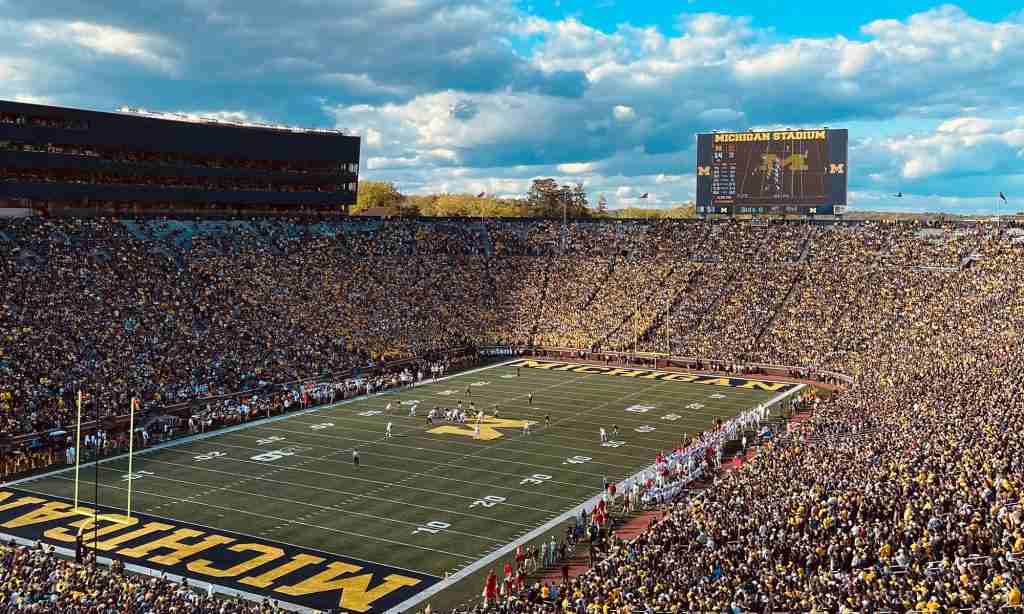The United States is home to some truly massive sports venues, places that can hold an unbelievable number of people. These aren't just simple fields; they are huge, impressive buildings that stand out as symbols of America's love for sports and big events. Imagine walking into a place where the cheers of tens of thousands of fans create an incredible, electrifying feeling you won't forget.
While many states have their own very large stadiums, there's one that holds a special title. This particular stadium is known for being the biggest in the entire country when it comes to how many people it can hold. It's a legendary spot for sports fans and anyone who loves being part of a giant crowd. It's a place where history is made, not just in sports, but also for other huge gatherings that bring people together from all walks of life.
Check Out: What is Polyworking? The Multi-Job Trend Reshaping the U.S
Michigan Stadium

When we talk about stadiums that can hold a truly incredible number of people and are famous all over the country, Michigan Stadium, often lovingly called "The Big House," stands head and shoulders above the rest. It proudly holds the title of the largest stadium in the entire United States.
You will find this enormous place in Ann Arbor, Michigan, and it's much more than just a place where games are played. While it's certainly a legendary spot for college football, a sport deeply ingrained in American tradition, "The Big House" has become a powerful symbol of America's strong and passionate sports culture. It represents those exciting Saturday afternoons where thousands of fans gather, cheering on their teams, creating an electric atmosphere that's truly unforgettable. It's a place where history is made, records are broken, and generations of fans share a common love for the game.
Location and Ownership
Michigan Stadium is right on the University of Michigan campus in Ann Arbor, Michigan. The University of Michigan owns and runs it, and it's mainly the home stadium for their football team, the Michigan Wolverines.
Capacity and Size
Michigan Stadium, often called "The Big House," is truly enormous! It can officially seat 107,601 people, which makes it the biggest stadium in the United States. Not just that, it is also the third-largest stadium in the world. Imagine how many people are cheering at once!
But here is a fun fact: even though its official number is 107,601, sometimes even more people squeeze in for really important games. To name one, during a major Notre Dame game in 2013, an astonishing 115,000-plus crowd packed the stadium! It is an arena that electrifies the crowd with its sheer energy, especially when that energy is complemented by a larger-than-life crowd.
History and Construction
Opening Date: October 1, 1927
Original Capacity: 72,000 seats or thereabouts
Architect: Bernard Green
Major Renovations: The stadium underwent various expansions and renovations, including a $226-million enhancement project finished in 2010, which brought in luxury boxes, wider seats, and modern amenities
Other Uses
"The Big House" isn't just for football games, even though that is what it's famous for. This huge stadium has also been used for other big events like international soccer matches, where teams from different countries play. It even hosted a major outdoor hockey game called the NHL Winter Classic in 2014. Apart from sports, many students have graduated while celebrating their graduation rites, and it is equally a venue used for major concerts and huge public meetings.
Global Recognition
By virtue of its size and energy-filled atmosphere, Michigan Stadium attracts, besides sportsmen, also tourists and architecture buffs. In a distinct way, it conflates the tradition, the pride, and the might of college sports.
If ever in Michigan, watching a game at The Big House will surely be an experience of a lifetime. Being the biggest stadium in the United States, its magnitude alone somehow reflects the spirit of American sports culture: loud, proud, and larger than life.
Must Read
Which is the Oldest Museum in the US? Check Origin Year and Other Facts
